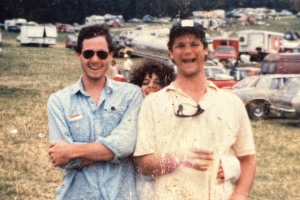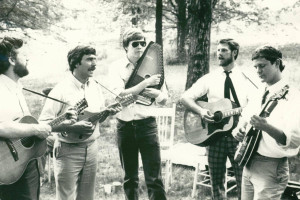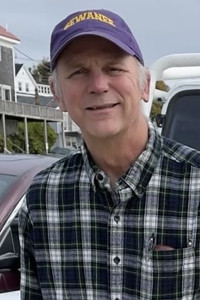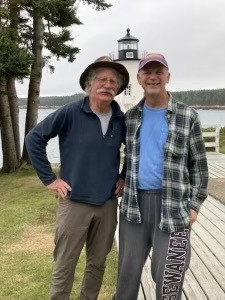"One thing I learned from my father is that you should give back to your community. I see Sewanee as my community."
Marshall Chapman, C’84, has a confession. If you attended Sewanee in the early 1980s and at one point wandered into a janitorial closet thinking it was your introductory biology class, it’s probably his fault. Around 2 a.m. on the first day of classes in 1982, Chapman and his buddy Matt Costello, C’84, sneaked into Woods Laboratories and unscrewed all the door numbers—then, they shifted the numbers down by one room and reattached them. Later that morning, predictable chaos ensued. “There were freshmen expecting an intro class who found themselves in an upper-level class, and we saw about a dozen freshmen trying to enter a broom closet,” Chapman recalls.

C'84, and a friend on their best behavior
That wasn’t the duo’s only prank. Chapman also obtained a specialized driver’s license so that he and Costello could borrow a school bus from St. Andrew’s-Sewanee School and conduct a driving tour of faculty homes, similar to the celebrity home excursions offered in Hollywood.
Then, there was their PG-13-rated 1983-1984 Men of Sigma Nu calendar. As Chapman explains, he and Costello caught wind that Sewanee’s Theta Kappa Phi (TKP) sorority was planning a Men of Sewanee calendar and no Sigma Nus had been invited to participate. Quickly, the two Sigma Nus rallied their fraternity brothers to create a competing calendar—with one notable difference. While the Men of Sewanee dressed in athletic jerseys or suits and ties, the Men of Sigma Nu wore nothing at all. Chapman says that the Sigma Nu calendar relied heavily on strategically placed props, and it came out two weeks before Men of Sewanee. “I don’t think anyone in Sigma Nu got a date from a TKP for years afterwards,” he laughs.
If Sewanee had offered a bachelor’s degree in hijinks, Chapman might have gone that route. Instead, he majored in religion and mapped out a career working in an upstate South Carolina textile mill owned by his family. His post-graduation plans seemed straightforward until his senior year at the University. That fall, he enrolled in a Physical Geology course taught by Professor of Geology Bran Potter, and “it completely turned my life around,” Chapman says.

Dr. Bran Potter, Dr. Van Nall, Ray Vaughn C'83,
Charlie Smith C'78, and Marshall Chapman, C'84
Though geology was new to Chapman at the time, he’d been acquainted with Potter for years. Not long after Chapman arrived on the Mountain, Potter heard him playing banjo on the porch of Tuckaway Hall. Bonding over their shared banjo and guitar skills, the two joined former Sewanee Forest Manager Charlie Smith, C’78, in forming a band, The Agents of Erosion. (As Chapman explains, the band’s name hinted at an informal tagline: “Slowly but surely, we’re wearing you away.”) Playing a combination of folk and bluegrass, the Agents entertained crowds across the local region, from Shenanigans and the Monteagle Assembly to Cowan. “It was really one of the most rewarding and memorable experiences of my Sewanee career,” Chapman says.
Potter’s geology course provided adventures across the Domain, too. As part of the curriculum, Potter led field research expeditions in Sewanee’s Shakerag Hollow and along other nearby trails. Though a bout of mononucleosis caused Chapman to miss out on one of the course’s highlights—a trip to the Great Smoky Mountains—he says the setback hardly affected his overall classroom experience. “Bran’s love and excitement for the discipline of geology really came through,” he says. “Having been a Boy Scout, everything about geology just clicked for me.”

With his religion degree in hand, Chapman scrapped his job plans and spent a year at Appalachian State University in Boone, North Carolina, completing prerequisites for a master’s program in geology. From there, he headed north to the University of Massachusetts at Amherst, where he earned M.S. and Ph.D. degrees in geology. A three-decade career in higher education followed. Most recently, Chapman taught geology for 27 years at Morehead State University in Morehead, Kentucky, before retiring last year.
Chapman notes that, during his time in academia, he frequently drew upon Potter’s teaching strategies. In particular, he made it a point to take students on field trips, so that they could put their coursework into practice. “There’s a difference between studying geology and doing geology,” he says. “As a professor, I found that students could understand course material and earn good grades, but they couldn’t really fall in love with the field unless they were out engaging with it.”
Drawing on his specialty, the geology of volcanoes, Chapman led students on excursions to study active volcanoes in places like Newfoundland and Hawaii. He also took a group of students to Isle au Haut, Maine, the 12-square-mile island where he conducted his M.S. and Ph.D. research. As he describes, Isle au Haut was created by a supervolcano and now has roughly 50 year-round residents. For several summers, Chapman lived in a 41-foot sailboat off the island’s coast, and between 2012 and 2019 he owned and operated a bed and breakfast in the island’s Keeper’s House—a renovated residence connected to a lighthouse. “I ran the inn during the summer, and then a general manager took care of it in the fall when I went back to teaching. So, I really had the best of all possible worlds,” he says.

Chapman says Potter has joined him on Isle au Haut many times: “When I owned the sailboat, Charlie Smith and Bran both came to the island, and we sat in the boat and played music together. We had a great time.” Fate may have played a role in orchestrating these jam sessions—Chapman points out that Potter taught him to play “Isle au Haut Lullaby” and “The Hills of Isle au Haut” on banjo at Sewanee, long before Chapman knew anything about the island.
When Chapman learned about the Cindy and Bran Potter Field Studies Endowment, a fund created by Scott Weber, C’94, and other friends of the Potters, he jumped at the opportunity to give. “My parents always taught me, ‘to whom much is given, much will be required,’” he says. Recently, Chapman provided a major gift that will significantly advance the endowment’s mission of supporting student field experiences within Sewanee’s Department of Earth and Environmental Systems. Vice President for University Relations Deborah S. Vaughn, P’20, says, “Marshall’s gift not only speaks to his generosity but also highlights and honors Bran and Cindy Potters’ extraordinary contributions to Sewanee as longtime educators and community-builders.”
Chapman has also supported the Sewanee Fund with a monthly recurring gift for more than a decade. “One thing I learned from my father is that you should give back to your community,” he says. “I see Sewanee as my community.”
Given the extent of Chapman’s Sewanee philanthropy, his former professors and classmates would likely forgive him for wreaking so much havoc on the Mountain as a student. He says he and Matt Costello only faced serious repercussions for one prank—removing a fading billboard by the old Sewanee Inn. “I had to resign as president of the Order of the Gown, and we got fined a great deal,” he notes. “But then we were allowed to keep the billboard, so we cut it into pieces and sold them to pay our fine. We actually made $10.”

